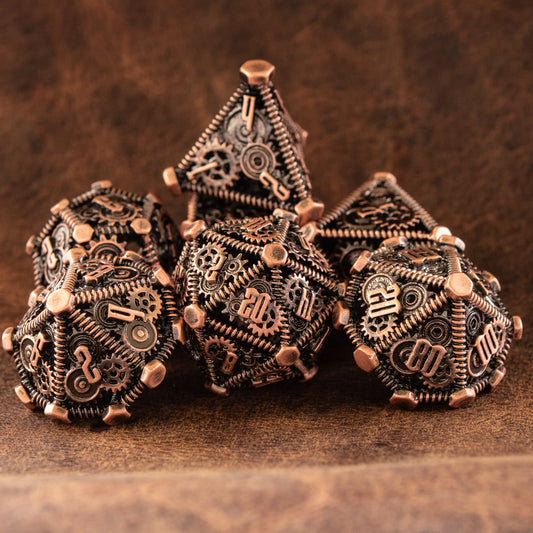How to Roll Percentile Dice in Dungeons & Dragons (D&D)
Share
In Dungeons & Dragons (D&D), percentile dice (often referred to as D100) are used to generate a random number between 1 and 100. These dice rolls play a crucial role in determining the outcome of random events, such as rolling on loot tables, resolving specific spells, or gauging the success of highly uncertain actions. In this guide, we will explain what percentile dice are, how to roll them, and when they are used in D&D.
What Are Percentile Dice?
Percentile dice are a special pair of ten-sided dice (D10) that, when rolled together, produce a number ranging from 1 to 100. They are usually marked with numbers 00 to 90 (representing tens digits) on one die, and 0 to 9 (representing ones digits) on the other die.
The two D10 dice are rolled simultaneously, with one die representing the tens digit and the other representing the ones digit. When combined, they create a two-digit number from 01 to 100. This is known as a percentile roll or a D100 roll.
Percentile Dice vs. Regular Dice
While other polyhedral dice in D&D (such as D20 or D6) are used to perform specific actions like attack rolls or damage rolls, percentile dice are usually reserved for situations where a large range of outcomes is needed. Unlike regular dice, which typically produce numbers within a more limited range (like 1 to 20), percentile dice allow for a much broader spectrum of possibilities, giving you a finer level of granularity in determining random outcomes.
How to Roll Percentile Dice
Rolling percentile dice may seem a bit different compared to other dice, but it’s a simple process once you understand it. Here are the steps to roll percentile dice in D&D:
Step 1: Identify Your Percentile Dice
Percentile dice consist of two ten-sided dice. One of the dice is marked with single digits (0–9), while the other is marked with multiples of ten (00–90). Some dice sets include a special D100 die, where both digits are rolled on one die, but most players use two separate D10s for this purpose.
Step 2: Roll Both Dice Together
Hold both dice in your hand and roll them simultaneously on a flat surface or inside a dice tray. Once both dice have come to rest, you will see two numbers: one representing the tens digit and the other representing the ones digit.
Step 3: Combine the Results
To interpret the result, simply combine the two numbers you rolled:
- The die marked with tens digits (00–90) shows the first digit of your number.
- The die marked with ones digits (0–9) shows the second digit.
For example:
- If you roll 40 on the tens die and 3 on the ones die, the combined result is 43.
- If you roll 90 on the tens die and 8 on the ones die, the result is 98.
- If you roll 00 on the tens die and 0 on the ones die, the result is 100, the highest possible result.
Handling Special Cases
There are two special cases to be aware of when rolling percentile dice:
- Rolling 00 and 0: This represents a roll of 100, not zero. In D&D, rolling 100 is usually the most favorable outcome on a percentile roll.
- Rolling 00 and any other number: If you roll 00 on the tens die and any number between 1 and 9 on the ones die (such as 00 and 3), the result is the corresponding single-digit number, in this case, 3.
Example Rolls
Here are a few example percentile rolls and their results:
- 00 on the tens die and 7 on the ones die = 7
- 60 on the tens die and 5 on the ones die = 65
- 20 on the tens die and 0 on the ones die = 20
- 00 on the tens die and 0 on the ones die = 100
When to Roll Percentile Dice in D&D
Percentile dice are used in various situations in D&D, typically to determine random events or outcomes. Below are some of the common scenarios where percentile dice come into play:
1. Rolling on Random Tables
Percentile dice are frequently used to roll on random tables, such as treasure or encounter tables in the Dungeon Master's Guide (DMG). These tables assign specific results to different ranges of numbers, allowing for a variety of outcomes.
For example, if you're rolling on a loot table, the table might look something like this:
- 01-10: Common item
- 11-50: Uncommon item
- 51-90: Rare item
- 91-100: Very rare item
In this case, rolling percentile dice helps determine what item the players receive based on where their result falls within the specified ranges.
2. Spells and Special Abilities
Certain spells and abilities use percentile rolls to gauge success, failure, or the magnitude of their effects. For instance, the reincarnate spell requires the caster to roll on a random table to determine the new form the creature takes after being resurrected.
Another example is the wild magic surge for sorcerers. When casting a spell, a wild magic sorcerer may be required to roll on a wild magic surge table to determine if something unpredictable happens. The percentile roll decides which of the many potential effects occurs.
3. Critical Failures and Successes
Some DMs use percentile dice to add more variety to critical hits and misses in combat. When a player rolls a natural 20 (a critical hit) or a natural 1 (a critical fumble), the DM may have the player roll on a critical success or failure table using percentile dice. This can lead to more nuanced effects beyond just dealing extra damage or missing.
4. Rare or Unlikely Events
Whenever an event has a low probability of happening, DMs may ask players to roll percentile dice to see if they beat the odds. For example, if the party is trying to perform an exceptionally difficult task with a slim chance of success, the DM might say, "Roll percentile dice. If you roll 95 or higher, you succeed."
5. Random Encounters
When traveling long distances or exploring dungeons, DMs sometimes use percentile dice to determine if the party encounters a random event. Depending on the roll, the party might face an unexpected encounter, such as hostile creatures, an NPC in need of help, or even a natural disaster.
Tips for Using Percentile Dice
Rolling percentile dice can add exciting elements of randomness to your D&D game, but here are a few tips to keep in mind:
- Use a Dice Tray: Since percentile dice require two dice to be rolled simultaneously, using a dice tray can help keep the dice contained and prevent them from rolling off the table.
- Be Clear with Your Rolls: When rolling percentile dice, make sure both you and your DM know which die represents the tens digit and which represents the ones digit. This prevents confusion and ensures the rolls are interpreted correctly.
- Keep Tables Handy: If you're rolling on a random table, keep the table within easy reach for quick reference. This helps maintain the pace of the game and allows you to quickly determine the result of your roll.
- Practice Reading Dice: Rolling percentile dice can take some practice to read quickly and accurately, especially for new players. Take some time to practice rolling and interpreting the results before using them in a game session.

